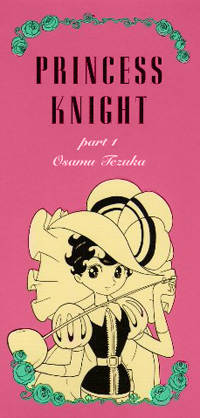 Prince Sapphire has a unique problem: he’s a she. Due to a heavenly mixup, Sapphire was born with both a boy and girl heart, but her mother must conceal this secret in order to protect the throne from the evil, opportunistic Duke Duralumin. Though he suspects the truth about Sapphire, he constantly attempts to employ devious means to expose this scandal before the entire kingdom and plant his dope of a son, Plastic, in Sapphire’s place.
Prince Sapphire has a unique problem: he’s a she. Due to a heavenly mixup, Sapphire was born with both a boy and girl heart, but her mother must conceal this secret in order to protect the throne from the evil, opportunistic Duke Duralumin. Though he suspects the truth about Sapphire, he constantly attempts to employ devious means to expose this scandal before the entire kingdom and plant his dope of a son, Plastic, in Sapphire’s place.
Princess Knight (Ribon no Kishi) debuted in Kodansha’s Shoujo Kurabu magazine in 1953, and starts off as one of the more playful and straight-up Disney-styled of Osamu Tezuka’s works. The first few chapters follow Sapphire from birth—a heart placement fudged by the good-natured but troublesome angel Tink—to adolescence, when the trouble with Duke Duralumin really comes to a head. Much of the early conflict is full of hat-stomping “drat and double drat!” failed villainy, with chapters ending on a gag rather than an exciting, twisting plot point.
This changes rather quickly as the story settles into a groove, abandoning what could easily become a tiresome formula. What waits beyond the opening chapters is an increasingly urgent tale full of action and narrow escapes. Sapphire’s matters are further complicated when she is eventually forced from her kingdom and stalked by a wicked witch, and remains at constant odds with the charming Prince who despises her “male” form but is utterly enamored by Sapphire when she’s decked out like a gorgeous flaxen-haired maiden.
Tezuka really flexes his action panel muscles here, with dynamic compositions and poses saving many a frame that would otherwise be entirely too busy. But beyond the artwork and the fast pacing, one simply can’t ignore the overall impact of Princess Knight and how it helped shape the world of shoujo comics. While the timeless, classical quality doesn’t lend many hints or whispers to the series’ historical significance to those not looking for or interested in them, perhaps that’s what makes Princess Knight so enduring.
Tezuka’s gender-twisting jaunt lives on in this fine release from Vertical Inc., and even those who don’t normally lean toward shoujo fare should find an oddly comforting sense of nostalgia in this first of two volumes.
Publisher: Vertical Inc.
Story & Art: Osamu Tezuka
© 2011 by Tezuka Productions

